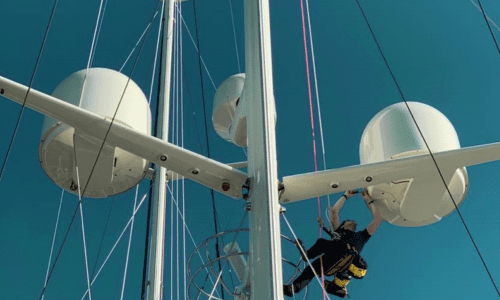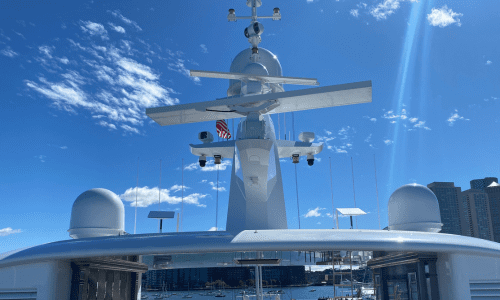The History of Superyacht Connectivity: The Tech Revolution
Over the years the superyacht industry has transformed dramatically. From growing vessel sizes to cutting-edge designs, change is constant. OceanWeb has been serving the industry since 1999, and we have seen first-hand the evolution of connectivity at sea. Gone are the days of limited, dial-up-like connections. Today, superyachts boast robust networks capable of supporting everything from crystal-clear video calls to lightning-fast data transfer.
Here we provide an overview of the superyacht tech revolution, from high-frequency radio to the high-speed connectivity of Starlink.
Pre 2000’s: High-frequency Radio (HF) & Satellite (L-Band)
Before the 2000’s hit, the superyacht industry relied on two primary, yet very limited communication solutions, these being high-frequency (HF) radio, and early satellite networks.
Utilising shortwave radio frequencies that “bounce” off the Earth’s atmosphere, HF radio offered long-range communication at sea. However, capabilities were restricted to basic voice call and telex messages. Additionally, reliability was heavily influenced by atmospheric conditions, leading to frequent interruptions and dropouts. While not the main source of connectivity today, HF radio still serves as a backup or emergency communication method in some cases.
In the 90s, satellite phone technology emerged based on either geostationary Inmarsat Satellites or Low Earth Orbit Iridium satellites. Inmarsat B and MiniM were two early satellite services offering voice and data which provided superyachts with an additional communication option. Inmarsat B was able to provide dial-up ISDN speeds of 64kbps as well as voice, whilst MiniM provided voice and data at just 2.4kbps – that’s a quarter fax speed! In comparison to HF radios, satellite phones offered an improved voice call service, with a more reliable connection. However, the high cost of satellite phone calls limited their usage to critical situations such as emergencies.
The 2000’s: The introduction of VSAT and faster L-band
The first ever maritime VSAT (Very Small Aperture Terminal) was deployed in 1986, however it wasn’t until the 2000’s that this revolutionary technology became an industry standard. A VSAT is a two-way ground station that transmits and receives data from geostationary satellites. VSAT technology was a significant industry leap forward as it allowed for faster data transfer, enabling crew and guests to utilise communication methods such as email and web browsing. Importantly, VSAT facilitates two-way communication, as opposed to pre-VSAT options such as high-frequency radio.
A second benefit was the reliability of this communication method. Superyachts are often exposed to harsh elements, VSAT signals are less susceptible to weather disruptions compared to HF radio.
The first ever maritime VSAT (Very Small Aperture Terminal) was deployed in 1986, however it wasn’t until the 2000’s that this revolutionary technology became an industry standard. A VSAT is a two-way ground station that transmits and receives data from geostationary satellites. VSAT technology was a significant industry leap forward as it allowed for faster data transfer, enabling crew and guests to utilise communication methods such as email and web browsing. Importantly, VSAT facilitates two-way communication, as opposed to pre-VSAT options such as high-frequency radio.
A second benefit was the reliability of this communication method. Superyachts are often exposed to harsh elements, VSAT signals are less susceptible to weather disruptions compared to HF radio.
Superyachts purchase VSAT airtime packages from providers like OceanWeb, with service level agreements guaranteeing network availability. These contracts are based on MIR (Maximum Information Rate) and CIR (Committed Information Rate), ensuring guaranteed minimum speeds. This provided a sense of security and predictable performance for crew venturing offshore. Due to its reliability VSAT remained the dominant source of connectivity for vessels, with the VSAT market experiencing significant growth from 2006 – 2020.


There were however two key downsides to this connectivity solution, its high cost and high latency. VSAT is significantly more expensive than any terrestrial internet service on the market, both in terms of airtime and the associated hardware and installation costs. High-bandwidth usage could easily exceed $20,000 per month. In addition, VSAT still had inherent latency issues, which became more problematic as digitalisation demanded greater bandwidth. These drawbacks ultimately paved the way for future advancements that are now widely used in 2024.
Whilst VSAT may no longer be the optimum connectivity option, it still plays a role as a highly reliable backup on most superyacht vessels. VSAT technology is also mature, very secure and is still preferred by government & military.
During this period, Inmarsat developed their Fleet services by launching Fleet broadband in 2008 – which offered speeds up to 432kbps and voice and are still used today. Iridium also developed their services with the Iridium Openport/Pilot offering fully global voice and data service at speeds up to 192kbps and now superseded by Iridium Certus with speeds of up to 900kbps.
The rise of bandwidth demand
From 2010-2020 the industry saw a steady rise in bandwidth demand, as superyacht owners and guests began to expect connectivity similar to what they have access to at home, such as streaming services, video conferencing and real-time social media updates. Superyacht data usage further skyrocketed during the global pandemic, as remote working increased. To facilitate increasing demand a number of vessels adopted hybrid models, utilising a number of connectivity methods such as 4G/5G, Marina wi-fi, Iridium Certus and Fleetbroadband. This gave vessels options, and the ability to spread bandwidth demands across various sources. The 4G/5G infrastructure is still developing and can provide very cost effective and fast (>100mbps) connectivity when close to shore or in marinas.
Bandwidth management also played a key role throughout this period. Techniques such as VLANs (Virtual Local Area Networks) were implemented on superyachts with more sophisticated networks, allowing bandwidth to be effectively managed through a priority system. For example, owners would receive greater bandwidth than the crew.
2022 to present day: LEO satellites and the connected yacht
LEO connectivity utilises LEO (Low Earth Orbit) satellite constellations, which are much closer to the earth, orbiting at an altitude of 500km to 1,200km, 50 times closer than traditional GEO satellites. This is the key to LEO’s biggest selling point, the low latency it offers.
As the satellites are located closer to the earth, the time it takes for data to pass from one point on a network to another is shortened. For superyachts using a LEO network, the latency is reduced by a factor of 15 to around 40 milliseconds. Another clear benefit for yachts sailing far North or South is LEO’s ability to provide a truly global coverage, unlike VSAT, which was unable to service the Arctic and Antarctic regions.
Starlink Maritime was the first to market in September 2022, offering monthly plans for as low as $250 and speeds of up to 220 Mbps. Starlink partnered with Kymeta (a US based Satcoms company) to provide flat panel antennas, a stark contrast to the large VSAT domes previously dominating the market. The Starlink service has seen adoption at a rapid pace, with owners, guests and crew all looking to benefit from the increased bandwidth availability. Whilst still new to the market, the general consensus is positive, with some concerns regarding potential network congestion in popular areas like ports and marinas.
OneWeb, a competitor in the LEO market, has also completed its initial constellation of 600 satellites (March 2023).The full roll-out of the service is still ongoing, however this entry signals the potential for a more competitive landscape in the coming years. This competition is likely to drive further improvements in service levels and affordability for superyacht users.
What’s next?
The future of superyacht connectivity is undoubtedly bright. While VSAT revolutionised communication at sea, its limitations paved the way for advancements like Starlink and OneWeb, offering unprecedented levels of bandwidth and global coverage.
As LEO technology matures and competition intensifies, we can expect even more affordable, accessible, and high-performance solutions such as Amazons Project Kuiper with 3,236 LEO satellites and China’s Guowang which plans to launch 26,000 satellites to cover the entire world! This will ultimately lead to high-speed connectivity at sea becoming as commonplace as it is on land.
Recent Comments